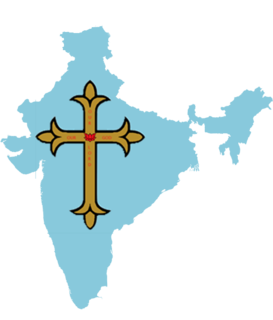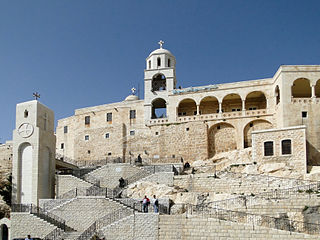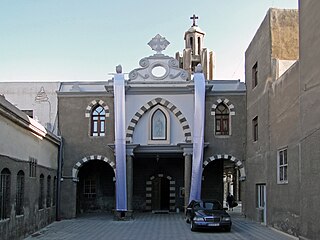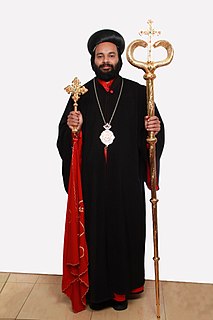
The Malankara Orthodox Syrian Church (MOSC) also known as the Indian Orthodox Church (IOC) or simply as the Malankara Church, is an autocephalous Oriental Orthodox church headquartered in Devalokam, near Kottayam, India. The church serves India's Saint Thomas Christian population. According to tradition, these communities originated in the missions of Thomas the Apostle in the 1st century. It employs the Malankara Rite, an Indian form of the West Syriac liturgical rite.

The Syriac Orthodox Church, officially known as the Syriac Orthodox Patriarchate of Antioch and All the East, and informally as the Jacobite Church, is an Oriental Orthodox church that branched from the Church of Antioch. The bishop of Antioch, known as the patriarch, heads the church, claiming apostolic succession through Saint Peter in the c. 1st century, according to sacred tradition. The church upholds Miaphysite doctrine in Christology, and employs the Divine Liturgy of Saint James, associated with James, the brother of Jesus. Classical Syriac is the official and liturgical language of the church.

The Greek Orthodox Patriarchate of Antioch, also known as the Antiochian Orthodox Church and legally as the Greek Orthodox Patriarchate of Antioch and All the East, is an autocephalous Greek Orthodox church within the wider communion of Eastern Orthodox Christianity. Headed by the Greek Orthodox patriarch of Antioch, it considers itself the successor to the Christian community founded in Antioch by the Apostles Peter and Paul.

Ignatius Zakka I Iwas was the 122nd reigning Syriac Orthodox Patriarch of Antioch and All the East and, as such, Supreme Head of the Universal Syriac Orthodox Church. Also known by his traditional episcopal name, Severios, he was enthroned as patriarch on 14 September 1980 in St. George's Patriarchal Cathedral in Damascus. He succeeded Ignatius Ya`qub III. As is traditional for the head of the church, Mor Severios adopted the name Ignatius.

The Malabar Independent Syrian Church (MISC) also known as the Thozhiyur Church, is a Christian church centred in Kerala, India. It is one of the churches of the Saint Thomas Christian community, which traces its origins to the evangelical activity of Thomas the Apostle in the 1st century.

Moran Mor Ignatius Jacob (Yaʿqub) III was the 121st Syriac Orthodox Patriarch of Antioch and head of the Syriac Orthodox Church 1957-1980. He was skilled in and knowledgeable in Syriac sacral music or Beth Gazo. He re-established the Maphrianate/Catholicate in the Jacobite Syrian Christian Church.

Christians in Syria make up about 10% of the population. The country's largest Christian denomination is the Greek Orthodox Church of Antioch, closely followed by the Greek Catholic Church, one of the Eastern Catholic Churches, which has a common root with the Eastern Orthodox Church of Antioch, and then by Oriental Orthodox Churches like Syriac Orthodox Church and Armenian Apostolic Church. There are also a minority of Protestants and members of the Assyrian Church of the East and Chaldean Catholic Church. The city of Aleppo is believed to have the largest number of Christians in Syria. In the late Ottoman rule, a large percentage of Syrian Christians emigrated from Syria, especially after the bloody chain of events that targeted Christians in particular in 1840, the 1860 massacre, and the Assyrian genocide. According to historian Philip Hitti, approximately 900,000 Syrians arrived in the United States between 1899 and 1919. The Syrians referred include historical Syria or the Levant encompassing Syria, Lebanon, Jordan and Palestine. Syrian Christians tend to be relatively wealthy and highly educated.

Saint Mary of the Holy Belt Cathedral is a historical Syriac Orthodox cathedral in Homs, Syria. It is the seat of the Syriac Orthodox Archbishop of Homs and Hama.

Kafr Buhum, also known as Kfarbou, is a town in central Syria, administratively part of the Hama Governorate, located 9 km southwest of Hama, 210 km (130 mi) north Damascus and 160 km (99 mi) south of Aleppo. Nearby localities include al-Rabiaa and Matnin to the northwest, Tayzin to the north, al-Khalidiyah to the east, Tell Qartal to the southeast, Birin to the south and al-Muah to the southwest. According to the Syria Central Bureau of Statistics (CBS), Kafr Buhum had a population of 12,194 in the 2004 census. Its inhabitants are predominantly Christian. It is 330 meters (1082 ft) above the sea level.

The Jacobite Syrian Christian Church (JSCC), or the Malankara Archdiocese of the Syrian Orthodox Church in India also known as Malankara Jacobite Syrian Orthodox Church, the Jacobite Syrian Church, and the Syriac Orthodox Church in India, is a catholicate based in Kerala, India, of the Syriac Orthodox Church of Antioch and part of the Oriental Orthodox Church. It recognizes the Syriac Orthodox Patriarch of Antioch and All the East as supreme head of the church. It functions autonomously within the church, administered by the Metropolitan Trustee, under the authority of the Maphrian of India, Baselios Thomas I. Following schism with the Malankara Orthodox Syrian Church, is currently the only church in Malankara that is directly under a Syriac Christian Antiochian hierarchy, claiming continuity to the 1665 schism. The church employs the West Syriac Rite Liturgy of Saint James.

Bab Tuma is an area of the Old City of Damascus in Syria, and is also the name of one of the seven gates inside the historical walls of the city, which is a geographic landmark of Early Christianity. The gate was named by the Byzantines to commemorate Saint Thomas the Apostle, one of the twelve apostles of Jesus Christ. The Romans first built the seven gates, and during their era, the gate was dedicated to Venus. The current gate was reconstructed by the Ayyubids in the 13th century.

Polycarpus Augin Aydın, is the Metropolitan and Patriarchal Vicar for the Archdiocese of the Netherlands of the Syriac Orthodox Church. The Metropolitan Seat is located at St. Ephrem the Syrian Monastery in Glane/Losser, the Netherlands.

Moran Mor Ignatius Aphrem II is a Syrian-American Christian prelate who has served as the Patriarch of the Syriac Orthodox Church since 29 May 2014.
Yaqub Mor Anthonios is a Syriac Orthodox bishop and Metropolitan of the Manglore Diocese.
Elias I of Antioch was the Patriarch of Antioch and head of the Syriac Orthodox Church from 709 until his death in 723. He is commemorated as a saint by the Syriac Orthodox Church in the Martyrology of Rabban Sliba, and his feast day is 3 November.

Syriac Catholic Cathedral of Saint Paul is the cathedral of the Syriac Catholic Church, located in Damascus, Syria. It is the see of the Syriac Catholic Archeparchy of Damascus and is located in the Christian quarter of Damascus, 100 m west of Bab Sharqi.

Mathews Mor Timotheos is a Syriac Orthodox bishop, he was Metropolitan Patriarchal Secretary For Indian Affairs.

The Holy Qurobo or Holy Qurbono refers to the Eucharist as celebrated in Syro-Antiochene Rite and the liturgical books containing rubrics for its celebration. West Syriac Rite includes various descendants of the Oriental Orthodox and Eastern Catholic churches. It consists of two distinct liturgical traditions: the Maronite Rite, and the Jacobite Rite. The major Anaphora of both the traditions is the Divine Liturgy of Saint James in Syriac language. The Churches are primarily based in the Middle East, Africa, and India.
















